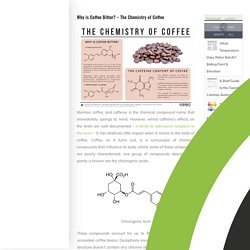

Best Espresso Machines. Untitled. 6 Great Coffee Subscriptions. Blue Bottle Coffee. The Coffee Brewing Handbook (SCAA) - Visions Espresso Service, Inc. Brewing Fundamentals. Unlike wine where the winemaker has complete quality control up to the time of bottling - coffee requires that the consumer to use a bit of their own craftsmanship during preparation.

This final step in coffee preparation is perhaps one of the most critical, since errors here can ruin the quality of the coffee and ultimately all the work that was invested into it. We will discuss in more detail the many variables that affect the quality of the brew, such as time, temperature, weight, water quality, particle size, etc. Fortunately much of the guess work in preparing a good cup of coffee has already been investigated by the Coffee Brewing Center (CBC) during the 1960's.
Led by Dr. Lockhart, his research has become the body of knowledge in truly understanding the physics and science behind coffee brewing. French Press Before discussing the fundamentals it is important to define some basic brewing terminology - strenght, extration and brew formula. Brewing Control Chart Much of Dr. Welcome to coffeechemistry.com. Everyday Chemistry - The chemistry that brews in your cup of coffee. The chemistry that brews in your cup of coffee Today there are cafe's everywhere and new ones keep cropping up.

Everyone enjoys a coffee break to catch up over a cup of coffee. Though we enjoy drinking a cup of coffee, few of us know that it is the chemistry behind your cup of coffee that makes it enjoyable? It all begins with a bean The coffee bean is where the chemistry of coffee begins. The importance of the aroma of the coffee You may not have realised it but it is the aroma of the coffee that makes it special.
You might be surprised to know that there are over 800 aromatic compounds of coffee. What is caffeine? Everyone grabs a cup of coffee if they want to stay awake. How does caffeine affect your body, heart and brain? Up to two cups of coffee a day doesn't affect you in any way. Drinking caffeine blocks adenosine, a chemical secreted by the nervous system to give the body a calming effect. Coffee Chemistry and Coffee Aroma. Coffee Chemistry: Coffee Aroma Coffee aroma is responsible for all coffee flavor attributes other than the mouthfeel and sweet, salt, bitter, and sour taste attributes that are perceived by the tongue.

Therefore, it might be said that coffee aroma is the most important attribute to specialty coffee. Chemistry in every cup. Coffee has a conflicting reputation - is it a guilty pleasure or a life saving elixir?

Emma Davies gulps down an espresso and investigates In ShortDrinking coffee has been associated with a variety of harmful and beneficial health effectsCoffee contains huge numbers of compounds, including antioxidant chlorogenic acids Recent evidence suggests coffee could help prevent type 2 diabetes and neurodegenerative diseases like Alzheimer's The absorption and profile of both helpful and harmful compounds in coffee is complex and depends on many factors It is hard to avoid stories about the latest must-eat food to join the anticancer brigade.
First it was select vegetables and berries, then red wine, dark chocolate and coffee. Newspapers frequently tell us that antioxidants 'fight (nasty) free radicals', and the words 'polyphenol antioxidants' have entered the mainstream. Kill or cure? Acid house Coffee contains a tremendous number of chemicals, with over 1000 aroma compounds. Digestive juices. Why is Coffee Bitter? – The Chemistry of Coffee. Mention coffee, and caffeine is the chemical compound name that immediately springs to mind.

However, whilst caffeine’s effects on the brain are well documented – it binds to adenosine receptors in the brain – it has relatively little impact when it comes to the taste of coffee. Coffee, as it turns out, is a cornucopia of chemical compounds that influence its taste; whilst some of these compounds are poorly characterised, one group of compounds about which plenty is known are the chlorogenic acids. Chlorogenic Acid These compounds account for up to 8% of the composition of unroasted coffee beans. Deceptively enough, despite the name their structure doesn’t contain any chlorine atoms – rather, it refers to the light green colour produced when these acids are oxidised. In medium to light coffee brews, the main source of bitterness is from chlorogenic acid lactones; the two dominant members of this family of compounds in coffee are shown below.
Phenylindanes References & Further Reading.